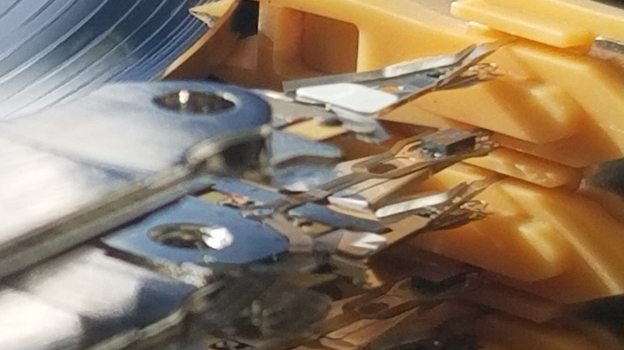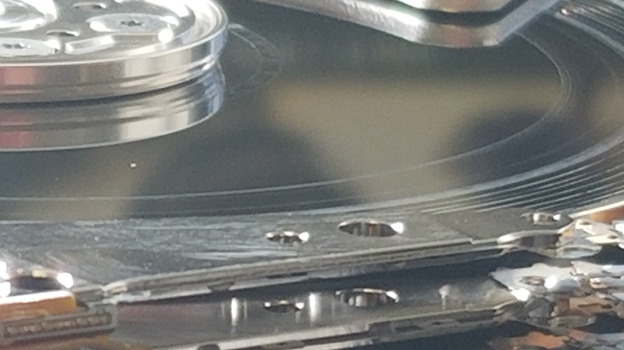
If you have experienced the unfortunate event of having a hard drive suddenly click or show signs of a mechanical failure, you probably also had to stop into your local data recovery center.
As part of the diagnostics report you probably saw the terms “bad heads” “dead heads” or “weak heads.” They all mean basically the same thing and what exactly inside of your computer is creating these bad heads?
Well, before I get to explaining all of this to you, let’s take a look at what those heads in question should look like under normal circumstances. The graphic below shows you a close-up of an actual head from a hard drive.
As you can see, they are not very big. Any idea what they are made from?
Usually, heads are made from a material called ferrite or a thin film of a magnetic material known as Permalloy. The magnetic properties are the reason why these materials have been chosen for hard drive heads. It permits them to read and write data on the hard drive platters.
The heads are attached to the hard drive head stack assembly (HSA). This article will spell out a complete hard drive strip down for you.
When a data recovery center uses the term “bad heads” or “dead heads” in their diagnostic report on the state of your hard drive, it means they have discovered an issue with that specific part of your drive.
What makes a head bad, weak, or dead?
Several types of failure can lead to this state. Here is a look at the most common of these:
1. Slightly misaligned or skewed heads resulting from a physical impact.
2. Manufacturers defect in the form of faulty heads. Sometimes when technology pushes the computer industry into overdrive to keep up, manufacturers have to stay up-to-date, and that sometimes results in raw, or unfinished devices going into the market. This tends to harm the quality of a specific product.
3. Dirty heads resulting from either a head crash or contamination. Like the surfaces of platters, head surfaces can get dirty with dust or magnetic dust collected from your platters. A washing and treatment are always required in this case and is because of the intricacy of the overall assembly. With today’s recording densities, one micro tiny dust speck on a platter surface could stop your head from reading several data sectors and will consider them “bad sectors.” a set of dirty heads covered with dust will either cause the drive to continuously click which can also damage the platters. Or, it could just keep rendering your drive with bad sectors.

4. Mangled or broken heads. This is a rarity, but it does happen. This will occur if the heads are parked in a dedicated parking ramp/zone. They can break and when they are used to attempt to enter the platters, the drive will keep trying to access the platters without success. Platter damage in this instance is usually restricted to the edge of the platters.
5. Finally… although this is not exactly a dead or bad head situation, it is certainly one that would be called weak heads. This term refers to the fact that the preamp stationed on the HSA is weak and the heads won’t read or write data… or, they will start reading but slowly or write in slo-mo. The best remedy here is a complete replacement of the HSA to recover data. Or, re-soldering the preamp from a donor (this was the common practice, but a complete HSA replacement is the better option).
Remember, the list above represents the most common reasons. There are many others, or there could be a combination of issues happening at the same time.
Some data recovery centers will detail with you what the failure is that is impacting your hard drive. Others do not do this and just explain the situation as just being bad heads. Asking follow-up questions the next time you find yourself in this situation will help you make an informed decision. Remember, if the data recovery center tries to sidestep your question, that is a sign that you should seek help from a different data recovery professional.
